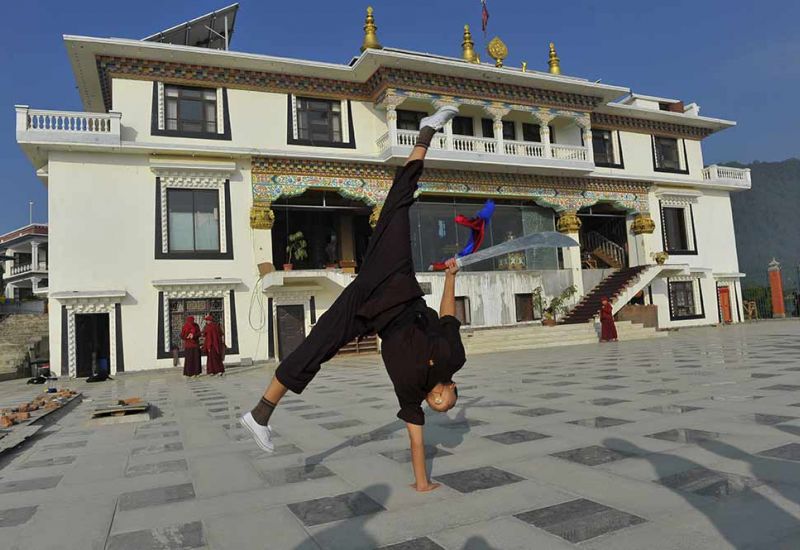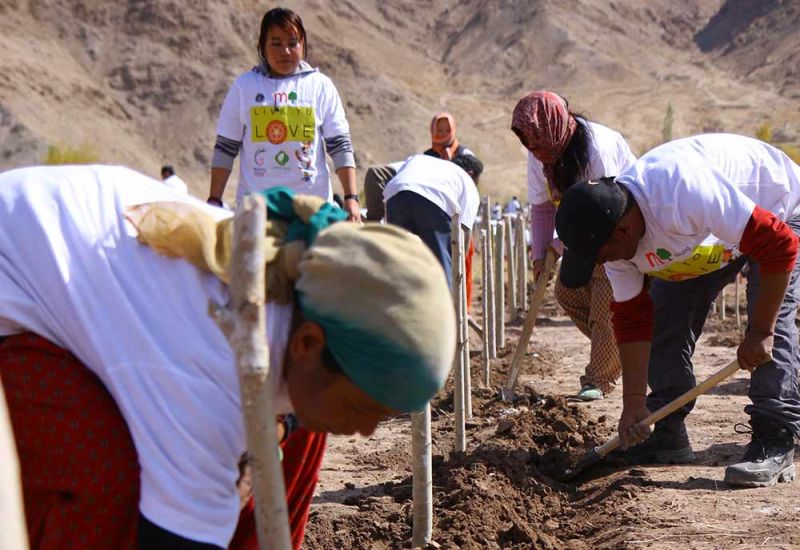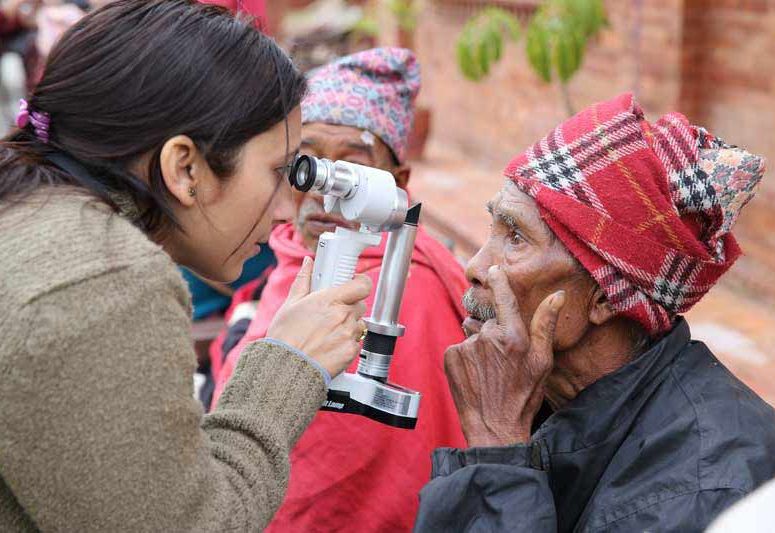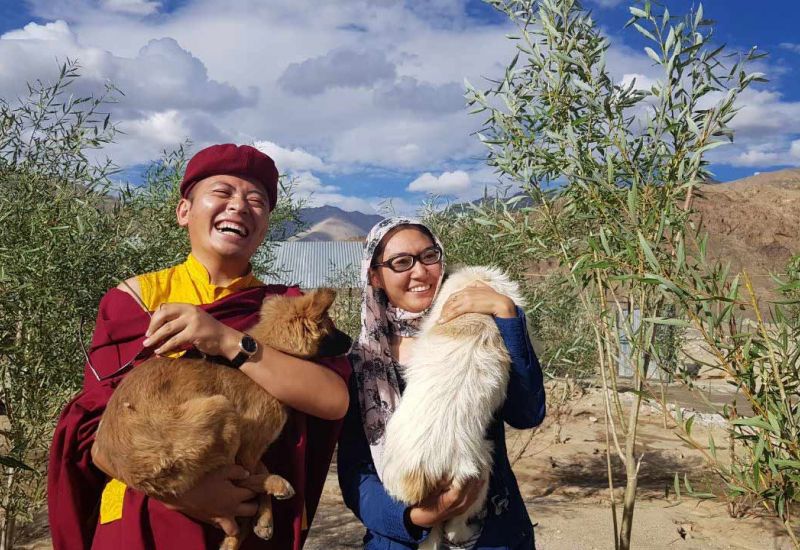Live to Learn
DRUK PADMA KARPO SCHOOL IN LADAKH/INDIA
Photos: © Agnes Forsthuber
The Drukpa Order,
a 800 years long lineage
The Drukpa Order is one of the most important Buddhist schools in the Himalayan region. The transmission lineage looks back on a heritage of more than 800 years. The central concern is the practical application of Buddhist teachings in daily life.
Worldwide, more than four million people are followers. There are Drukpa centers in many European countries, in North and South America and throughout Asia, especially in Bhutan, Nepal and India. The main European center is located in Plouray, France.
“Let go of winning and losing, of trying to be better than others. Do your best.”
The Gyalwang Drukpa
Urbuddha Vajradhara Tilopa (988-1069)
Naropa (1016-1100)
Marpa (1012-1099)
Milarepa (1040-1123)
Gampopa (1079-1153)
Pagmo Drupa (1110-1170)
Lingchen Repa (1128-1188)
Then incarnated the Gyalwang Drukpas
1. Gyalwang Drukpa Tsangpa Gyare Yeshe Dorje (1161-1211)
2. Gyalwang Drukpa Gyalwa Kunga Paljor (1426-1476)
3. Gyalwang Drukpa Jamyang Chödrak (1477-1523)
4. Gyalwang Drukpa Künkhyen Pema Karpo (1527-1592)
5. Gyalwang Drukpa Pagsam Wangpo (1593-1641)
6. Gyalwang Drukpa Mipham Wangpo (1641-1717)
7. Gyalwang Drukpa Thrinley Shingta (1718-1766)
8. Gyalwang Drukpa Künzig Mipham Chökyi Gyatso (1767-1822)
9. Gyalwang Drukpa Mipham Chökyi Gyatso (1823-1883)
10. Gyalwang Drukpa Mipham Chökyi Wangpo (1884-1930)
11. Gyalwang Drukpa Tenzin Khenrab Gelek Palzangpo (1931-1960)
12. Gyalwang Drukpa Jigme Pema Wangchen (geb. 1963)
“Nothing is impossible. Anything is possible in this world. We all can make it a better place for everyone.”
H.H. Gyalwang Drukpa
LIVE TO LOVE
The Drukpa Order, in addition to the spiritual life and traditional teachings, is very focused on the diverse humanitarian projects, which have become internationally known beyond the Himalayan region under the umbrella of "Live To Love".
In 2007, the Gyalwang Drukpa founded the worldwide initiative Live To Love, which, among other things, was awarded by the United Nations in 2010. This understands itself clearly secular and belongs to no denomination.
Based on the ideals of charity and human dignity, the cornerstones of Live To Love are:
The Drukpa Order designed and built the Druk Padma Karpo School in Ladakh, India, which is now run by Live To Love International. The curriculum combines the roots of Ladakhi culture with a modern education, opening up a wide range of future opportunities for the students.
With a special construction method that cleverly combines modern architecture, sustainable design and local resources, the Druk Padma Karpo School has already won various architectural awards, including "The Best Building in Asia", "The Best Teaching Building", and "The Most Environmentally Friendly Building" in 2002.

DRUKPA NUNS STUDY AND TEACH KUNG FU
The Gyalwang Drukpa is strongly committed to the profound education of female practitioners. In addition to the complex subjects taught in the philosophy of Vajrayana and Mahayana Buddhism, the nuns are trained in Kung Fu, medicine and hygiene, languages, computer technology, solar technology, gardening and landscaping, organic farming, and in the management and implementation of Live To Love activities.
They pass on their knowledge through self-defense workshops and are versed in business basics - to run a café or store. They are responsible for the care of their monastery, including the temples, the stupa and the gardens.
After the earthquake in Nepal, the nuns visited the people in the remote mountain villages and provided acute crisis intervention with great dedication. Live To Love International initiated a major fundraising campaign for this purpose.

PLANTING TREES IN THE HIMALAYA
With the help of thousands of locals, 150,000 trees were planted in a short period of time in 2010 and 2012 in Ladakh in northern India under the umbrella of Live To Love. For his activities during this period, the Gyalwang Drukpa received India's "Green Hero Award" and became a member of the UN's "Earth Award" committee. He was also honored with the "Lifetime Achievement Award".

THE DRUK WHITE LOTUS CLINIC
The clinic is located in Swayambhu, Kathmandu and combines modern and traditional medical healing methods. The focus is on dental treatment and ophthalmology, among others. A pharmacy is integrated into the clinic, where numerous training courses are also offered. Families of patients can find accommodation here during treatment times.
In regions where medical care is not readily available, Live To Love provides temporary "camps" of doctors to provide basic care to the local population.
During the Covid pandemic, the nuns of the Drukpa order supported the people in the mountain villages, distributing health packages and providing health education.
Thousands of people in the Himalayas have already been treated for eye diseases in so-called Eye Camps. In the Himalayas, there are many cases of cataracts, which, if left untreated, can lead to total blindness. Under the umbrella of Live To Love, free eye surgeries are performed, restoring sight for many.

AN ANIMAL PROTECTION PROJECT
His Eminence Drukpa Thuksey Rinpoche, in collaboration with the Gyalwang Drukpa, the Young Drukpa Association and Live To Love in Ladakh, has initiated the animal welfare project Live To Rescue. Live To Rescue takes care of street dogs and other animals in need. Here, injured animals are taken in, treated, cared for and, if possible, placed with families. In terms of animal welfare, Live To Rescue is a lighthouse project in the entire Himalayan region.
Detailed information on how Live To Love's philosophy is put into practice can be found on the websites of Live To Love International and Live To Love Germany.
Please agree to the use of essential cookies.